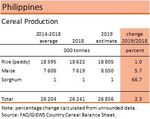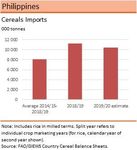GIEWS Country Brief The Philippines
←
→
Page content transcription
If your browser does not render page correctly, please read the page content below
GIEWS Country Brief
The Philippines
Reference Date: 12-June-2020
FOOD SECURITY SNAPSHOT
Harvested area of 2020 main paddy crop forecast at
near-average level
Cereal production in 2019 forecast at average level
Above-average cereal imports forecast for 2020/21
marketing year (July/June)
Prices of rice increased in April and May 2020 but
remained below year-earlier levels
Harvested area of 2020 main paddy crop
forecast at near-average level
Planting operations of the 2020 main paddy crop is underway
and is expected to continue until August in some areas. The
harvest of the early-planted crops will begin in July. Rainfall was
generally below average over the main producing areas in April,
leading to some delay in planting. Rains improved since early
May allowing planting operations to resume in most areas and
benefitting crop establishment. As of mid-May, remote sensing
data shows average to above-average vegetation conditions
throughout most of the country, except in the provinces of Sultan
Kudarat and South Cotabato located in southern Mindanao (see
ASI map). Despite the low market prices, which are prompting
farmers to switch to crops that are more remunerative, the
harvested area is expected to contract only marginally compared
to the average levels. This is due to the Government’s support in
terms of provision of high quality seeds, concessionary credits
and training. The Government is also investing in farm
mechanization and irrigation infrastructure in order to enhance
paddy productivity. The 2020 secondary paddy crop will be
planted towards the end of the year.
Planting of the 2020 main maize crop is nearing completion and
harvesting of early-planted crops is expected to start in July. The
area planted increased to record levels, supported by strong
demand from the poultry industry. The 2020 secondary maize
crop will be planted from October onwards.
In mid-May 2020, the country was also hit by Typhoon Ambo
(International Name: Vongfong) that brought heavy to intense
rainfall in the different regions of the country resulting in an
estimated agricultural damage of PHP 1.14 billion
(USD 22 million) most of which are high value crops. About
20 650 hectares of agricultural areas were damaged in Central
Luzon, CALABARZON and Eastern Visayas.
GIEWS global information and early warning system on food and agricultureCereal production in 2019 forecast at average level The 2019 cropping season will conclude by June 2020 and production is forecast at 26.9 million tonnes, slightly above the five-year average. The 2019 aggregate production of paddy rice is forecast at 18.8 million tonnes, close to average levels. The harvested area of both main and secondary paddy crops is estimated to have contracted compared with the previous year’s level as farmers shifted paddy land to other crops due the low farm gate prices. Weather conditions were overall conducive during the critical development stages of the main season crops and irrigation water supplies were adequate for secondary crop development. The 2019 production of maize is estimated at 8.1 million tonnes, 5 percent above the five-year average, mainly reflecting the high level of plantings, supported by strong demand from the feed industry and above-average yields. Above-average cereal imports forecast for 2019/20 marketing year (July/June) Aggregate cereal import in the 2019/20 marketing year (July/June) are forecast at 10.4 million tonnes, well above the five-year average after the steady increases registered since 2016/17. Imports of wheat in the 2019/20 marketing year (July/June) are forecast at 7.2 million tonnes, close to the previous year’s high level, due to sustained demand for high quality wheat for milling and lower quality for feed. Imports of rice in the 2020 calendar year are expected at 2.8 million tonnes, up 3 percent from 2019, mostly reflecting strong domestic demand. Maize import requirements in the 2019/20 marketing year (July/June) are forecast at 600 000 tonnes, close to the five-year average. Prices of rice increased since April, supported by strong local demand due to COVID-19 Prices of regular and well-milled rice increased in April and May 2020, after a protracted declining trend since late 2018, mainly due to hording and panic-buying due to the COVID-19 pandemic. However, average rice prices in May were below their year-earlier levels reflecting adequate market supplies from the near-average 2019 production and high level of imports. GIEWS global information and early warning system on food and agriculture
COVID-19 and measures adopted by the
Government
Starting from 16 March 2020 and until further notice, as a
measure to prevent the spread of the virus, the Government
imposed restrictions on international and national flights,
prohibited large gatherings of people and closed schools and
universities. Productive and commercial activities along the
food value chain have been allowed to operate amid the
lockdown restrictions, with special transport permits granted for
the movement of food items, agricultural inputs and labourers.
On 9 April 2020, the Government launched a four-pillar
socio-economic programme (officially called “The Duterte
Administration’s Philippine Programme for Recovery with
Equity and Solidarity” or PH-PROGRESO) against COVID-19.
This economic recovery programme transitions the “Bayanihan
to Heal as One” Law enacted in 23 March 2020, declaring the
country in national emergency from COVID-19. The
PH-PROGRESO includes fiscal and monetary measures as
well as increased financial resources to strengthen the health
sector and provide extra support to vulnerable households.
On 19 May 2020, the Government announced plans to allocate
about PHP 595.6 billion (USD 11.9 billion) for the emergency
support to vulnerable groups. These measures include:
A PHP 205 billion (USD 4.1 billion) cash support
programme availed by 12 million low-income households.
Each household is eligible to receive cash transfers of
between PHP 5 000 (USD 100) and PHP 8 000 (USD 160)
per month for a period of two months. An additional
5 million households will be identified for the second
tranche.
PHP 59.9 billion (USD 1.18 billion) social protection
measures for vulnerable workers, including
o PHP 51 billion (USD 1.02) wage subsidy for
employees of small business.
o PHP 1.5 billion (USD 30 million) for overseas Filipinos.
o PHP 3.2 billion (USD 64 million) to the Department of
Labour and Employment for assistance to the affected
formal workers.
o PHP 3 billion (USD 60 million) to the Department of
Agriculture for cash assistance to rice farmers.
o PHP 1.2 billion (USD 24 million) to the Social Security
System for unemployment benefits.
o PHP 123.7 billion (USD 2.44 billion) for credit support
to small businesses and support to the agriculture
sector.
o PHP 16.5 billion for the support to the rice programmes
to increase productivity and boost buffer stocks
Disclaimer: The designations employed and the presentation of material in this
information product do not imply the expression of any opinion whatsoever on the
part of FAO concerning the legal status of any country, territory, city or area or of
its authorities, or concerning the delimitation of its frontiers or boundaries.
GIEWS global information and early warning system on food and agricultureYou can also read






















































